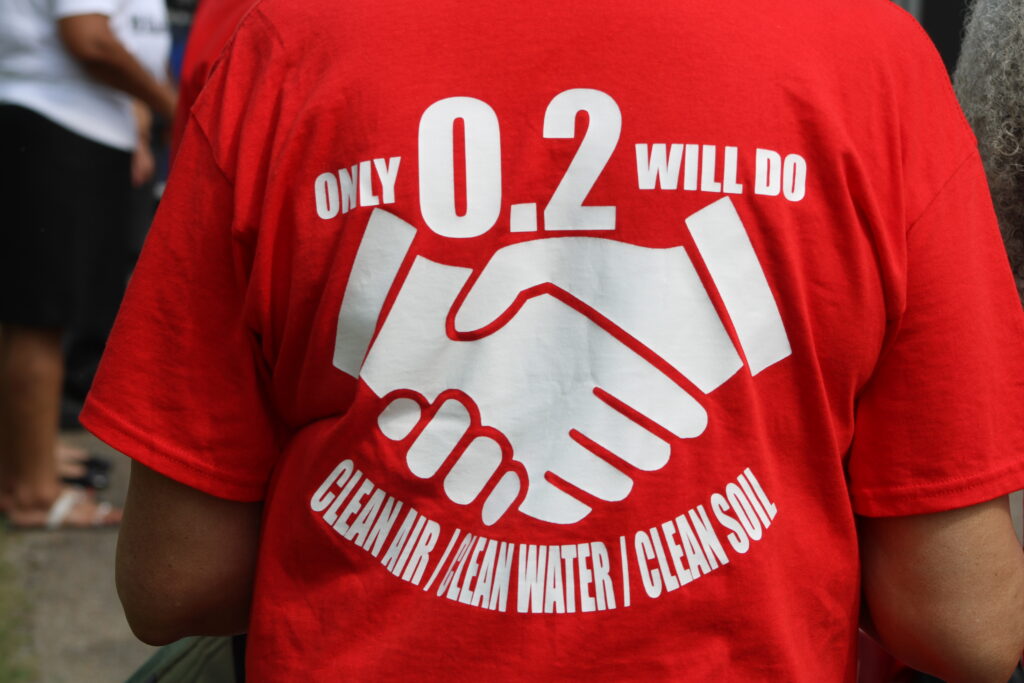A member of Concerned Citizens of St. John the Baptist Parish wears a T-shirt that says “Only 0.2 will do – clean air, clean water, clean soil. The shirt references the acceptable levels of carcinogen as determined by the U.S. Environmental Protection Agency’s Integrated Risk Information System, or IRIS. (Greg LaRose/Louisiana Illuminator)
Black residents living in some of Louisiana’s most heavily industrialized communities are turning to the U.S. Department of Justice for protection against further expansion of the polluting facilities already impacting their health and quality of life.
They see the federal government as their only option, accusing state leaders of selling out their lives to industry.
“We have a legislature in Louisiana that has been bought and paid for. (They) will not do anything to protect these communities,” Pastor Gregory Manning said at a press conference this week. He was joined by Black residents living in the industrialized corridor in southeast Louisiana dubbed “Cancer Alley.”
“The burden falls upon the DOJ and the federal government to step in and protect these communities,” said Manning, who leads the Greater New Orleans Interfaith Climate Coalition.
Manning and the small group of local activists attended a community meeting the DOJ held Monday at Southern University’s New Orleans campus. They urged the federal agency to take whatever legal steps it could to block the further expansion of petrochemical facilities in their communities, which have been disproportionately impacted by pollution.
The pleas come nearly a year after residents in Cancer Alley pushed the U.S. Environmental Protection Agency to mandate that all polluting facilities governed under the Clean Air Act have fenceline air monitors to track emissions levels, limit their excessive flaring events, install systems to detect chemical leaks and close certain loopholes around provisions that allow increased emissions releases during extreme weather events such as hurricanes.
EPA is also under pressure from 23 Republican state attorneys general to stop taking race into account when regulating pollution. On the state level, Louisiana Gov. Jeff Landry recently signed into law a measure that prohibits state environmental officials from using community-led air pollution monitoring results in enforcement actions.
Residents living in Cancer Alley have been pressing the federal government to intervene following the EPA’s decision last year to close an investigation into civil rights complaints from residents in St. John the Baptist and St. James parishes. They had accused the state of not protecting them from decades of pollution from the oil and gas and petrochemical industries.
Environmental Protection Agency Administrator Michael Regan, left, embraces Robert Taylor, head of Concerned Citizens of St. John the Baptist Parish. Regan was in LaPlace on April 6, 2023, to announce proposed regulations for chemical plants. (Greg LaRose/Louisiana Illuminator)
EPA Administrator Michael Regan has tagged environmental justice as a top priority of his tenure. He has said the agency is making strides toward better regulation of polluting facilities. Despite that, EPA was unable to reach agreement with the state’s Department of Environmental Quality on the civil rights probe, prompting federal authorities to shut it down.
DOJ officials this week began a six-city tour to gather comments from the public for the department’s Environmental Justice Strategic Plan, which by 2023 executive order seeks to reduce the health hazards and offer remedies living in communities overburdened by industrial pollution.
Such communities, “face entrenched disparities that are often the legacy of racial discrimination and segregation, redlining, exclusionary zoning, and other discriminatory land use decisions or patterns,” President Joe Biden said in his order, including “the placement of polluting industries, hazardous waste sites, and landfills in locations that cause cumulative impacts to the public health of communities.”
The DOJ is asking for public input on the goals and objectives it should include in the plan, how the agency can better engage marginalized communities and what topics its staff should be trained for in regards to environmental justice-related issues. The deadline to submit public comments was recently extended until July 22.
At Monday’s press conference, Barbara Washington with the nonprofit environmental advocacy group Inclusive Louisiana said she had lost her sister, several classmates, friends and relatives to cancer, which she blames on decades of pollution from the petrochemical facilities in St. James Parish.
“Whether it be prostate cancer, lung cancer, breast cancer; I’ve seen so many of my relatives and friends pass on from cancer,” said Washington, who has polluting facilities to the east and west of her home. “We’re here to ask the Department of Justice to do something about it because our state and local government have failed us.”
Washington noted recent research from Johns Hopkins University which asserted that the emissions of ethylene oxide from petrochemical facilities in Louisiana’s Cancer Alley were nine times higher than what was permitted by the EPA and Louisiana’s DEQ. Exposure to ethylene oxide has been linked to increased risks of certain types of breast and lymphoid cancer.
The DOJ did not respond to a request to comment on the statements made at Monday’s press conference.
After making another stop in Louisiana this week, the DOJ has community meetings in Connecticut and Virginia next month to gather more public comments. A draft of the strategic plan is scheduled to be posted online and submitted to the president’s Council on Environmental Quality in October.
Floodlight is a nonprofit newsroom that investigates the powerful interests stalling climate action.
The post Louisiana ‘Cancer Alley’ residents ask for fed help in pollution fight appeared first on Louisiana Illuminator.

